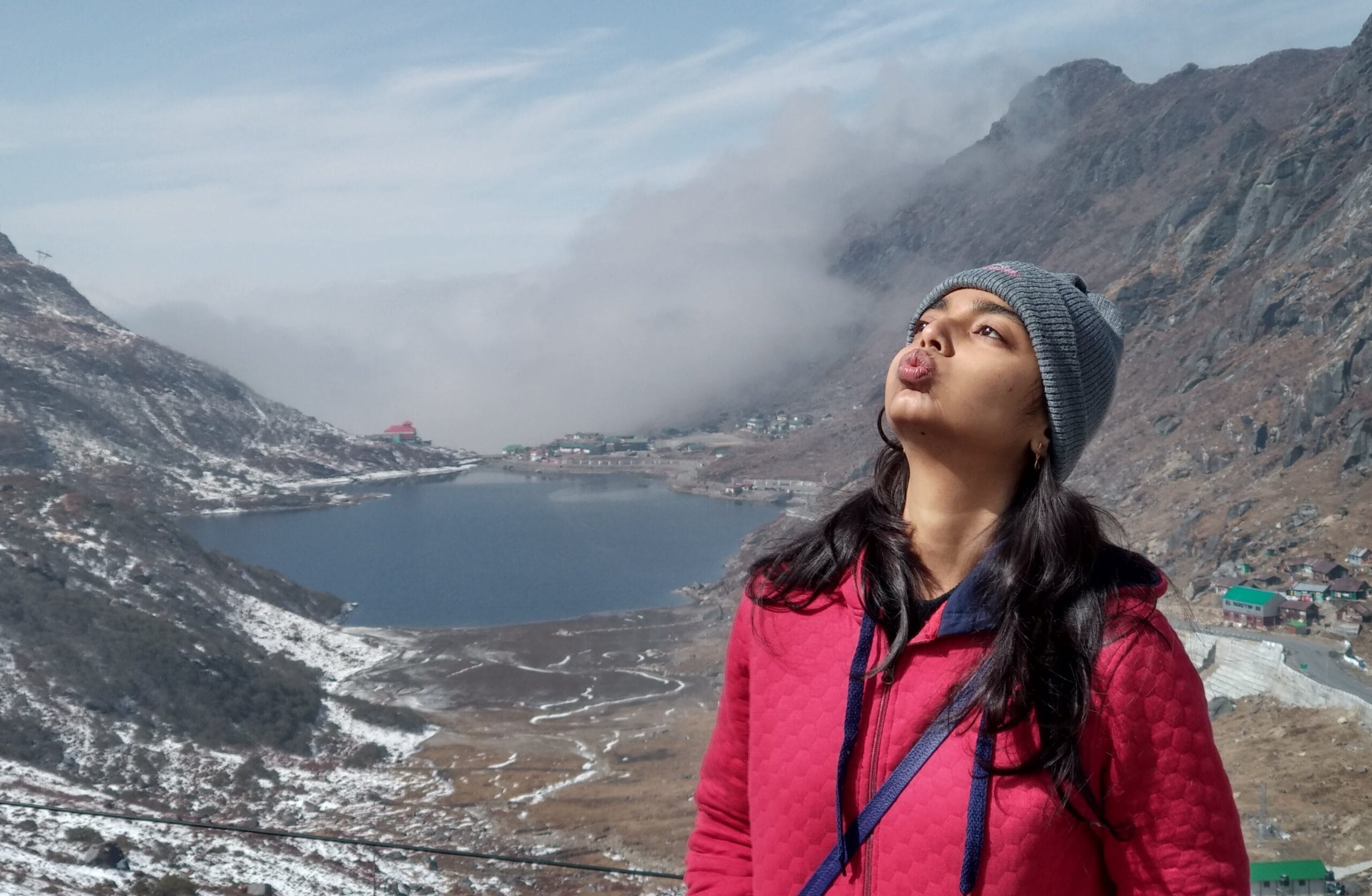Tsomgo Lake, also known as Changu Lake, is a mesmerizing glacial lake nestled amidst the rugged terrain of the Eastern Himalayas in the state of Sikkim. Its name, “Changu,” translates to “source of the lake” in the Bhutia language. This lake is highly revered as a sacred lake by the local Buddhists and Hindus alike.
Tsomgo Lake with its breathtaking beauty and cultural significance has become a popular tourist destination in Sikkim. Visitors from around the world are drawn to its tranquil waters, surrounded by snow-capped peaks and vibrant alpine flora. If you are planning a visit to Sikkim, then this lake must be on your itinerary. Read on to know more.
Geography and Location of Changu Lake (Tsomgo Lake)
The lake is located in the East Sikkim district near the Indo-China border. It lies at an altitude of about 3,753 meters (12,313 feet) above sea level. Steep mountains surround the lake, and its waters reflect the surrounding peaks, creating a picturesque and serene atmosphere.

Tsomgo Lake was formed due to glacial activity caused during the last Ice Age, which sculpted the landscape of the Himalayas. The lake, nestled in a valley surrounded by steep mountains, was created by the accumulation of melted ice and snow over thousands of years. Its pristine waters reflect the azure sky and the towering peaks, creating a spectacle of unparalleled beauty.
With a depth of around 48 feet and spreading over 1 kilometer, the magnificent oval-shaped Changu Lake is a picturesque beauty. The lake is fed by the melting snow of the surrounding mountains, and hence this lake never dries up. Tsomgo Lake or Changu Lake is also the place of origin of Lungtse Chu River. This azure blue lake remains completely frozen during winter.
Things to see in Tsomgo Lake
The journey to Changu Lake from Gangtok is also quite enchanting, where you can view several waterfalls en route. This oval-shaped deep blue lake is a true visual treat. For the best panoramic view of the lake (and hence the best photos) you will find it after crossing the lake on the way to Baba Harbhajan Singh Mandir.
During winters the lake remains frozen, along with its surrounding region. The Tsomgo Lake remains frozen up to April. After the winter season ends in the middle of May, the periphery of the lake has scenic blooms of flower species of rhododendrons (the state tree of Sikkim), primulas, blue and yellow poppies, and irises. In the precincts of the lake, you can also spot several species of migratory birds including Brahminy ducks. It is also believed that the forests around the Lake are home to the red panda.

When you enter the area of the lake, a small bridge will take you to a viewpoint cum cafeteria, from where you can view the complete lake and its surrounding mountains. There is also a small temple dedicated to Lord Shiva built at the lakeside that you can visit.
You can also trek along the lakeside in deep snow during winter or enjoy Yak rides along the border of the lake. There is a small rustic market before entering Tsomgo Lake which sells yak cheese, trinkets, and local curios for tourists. Adventure seekers can also enjoy trekking at the surrounding Kyonqnosla Alpine Sanctuary. You would also get snow boots and gumboots on hire from here. There are a few eateries and shacks that sell Momos and tea in this area.
The only road here is the Gangtok – Nathula Highway that goes to the Baba Harbhajan Singh Mandir and then the Nathula Point from Serathang. However, visiting these places requires a special permit since they are close to the Indo-China border.
Tsomgo Lake Legends
The Tsomgo Lake is shrouded in myths and legends. It is said that in ancient times, the Lamas (Buddhist Saints) used to predict the future by observing the lake’s color. If the water of the lake had a dark tinge, they predicted the future to be dark and gloomy, full of unrest. The faith healers of Sikkim, popularly known as Jhakhris also visit this lake during Guru Purnima to offer prayers.
Tsomgo Lake holds significant cultural and religious importance for the local Sikkimese people, particularly the indigenous Bhutia and Lepcha communities. It is considered sacred by the locals and is often visited by pilgrims. The lake is also revered as a wish-fulfilling lake by Buddhist monks.

Tsomgo Lake/Changu Lake Weather
During winters (that is January to mid-May) Tsomgo Lake is completely covered in snow and you can enjoy trekking as well as Yak ride on snow along the periphery of the lake. From October to December, the lake is partly covered in sheet ice and migratory birds can be seen waddling in the lake’s water. From April to July, you can witness a good bloom of flowers and rhododendrons which are the state tree of Sikkim.
Every season renders the lake in a different hue and fervor, so visit whenever suits your preferences.
Cultural Significance
For the indigenous Bhutia and Lepcha communities of Sikkim, Tsomgo Lake holds deep cultural and religious significance. It is considered sacred, with legends and folklore woven around its mystical aura. The lake is believed to be a dwelling place of mountain deities, and pilgrims visit it to offer prayers and seek blessings. Buddhist monks also regard Tsomgo Lake as a place of spiritual importance, with the surrounding landscape serving as a serene backdrop for meditation and reflection.
Changu Lake holds deep cultural and religious importance for the indigenous communities of Sikkim, particularly the Bhutia and Lepcha peoples. It is considered sacred, believed to be the abode of mountain deities, and holds a place of reverence in local folklore and traditions. Pilgrims often visit the lake to offer prayers and seek blessings, while Buddhist monks regard it as a site for meditation and spiritual reflection.
If you are looking for options in Kashmir, check out my posts on Pahalgam, Gulmarg, Snowfall in Kashmir, and Best time to Visit Kashmir. If you are looking for options in Ladakh, check out Ladakh Weather, Nubra Valley, 5 Days Kashmir Itinerary, Best Packing tips for Ladakh & best tourist places in Ladakh.
If you are looking for places to visit in the Andaman Islands, please check my post on Radhanagar Beach & Ross Island. For options in Uttaranchal check Kausani.
If you are looking for other seaside options, check my posts on Murud Janjira, Kashid, and Kihim Beach in Maharashtra or Malshej Ghat. Alternatively, if you are interested in some Religious tourism, please check my posts on Golden Temple, Kamakhya, Trimbakeshwar, and Kashi Vishwanath. If you are looking for North East Adventure tours, check my posts on Shillong, Meghalaya, Dawki, Double Decker Living Root Trek, and 7 Day North East Itinerary.
If you are looking for some spirituality, you can check out Ganga Aarti in Dashashwamedh Ghat or Ghats in Varanasi. Check out my posts from South India Sri Venugopala Swamy Temple, Bandipur Safari, and Mandalpatti Peak.


It’s an amazing paragraph for all the online viewers; they will
obtain benefit from it I am sure.
This article is actually a fastidious one it assists new net viewers, who
are wishing in favor of blogging.